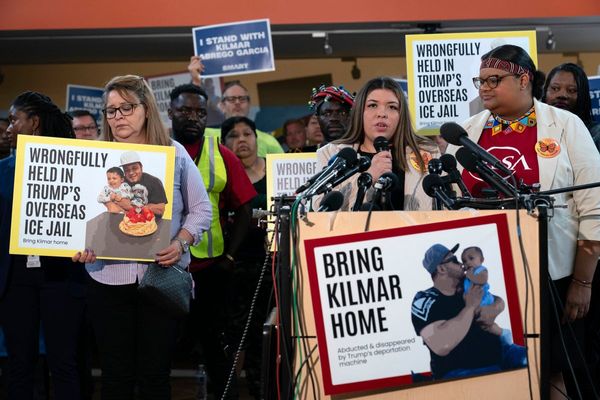WASHINGTON — The White House Situation Room only sends out alerts in the middle of the night to wake up top officials when a significant event in the world requires an immediate government response. The collapse of Champlain Towers South in Surfside was one of those nights.
Shortly after the condo building collapsed around 1:25 a.m. on June 24, senior officials on the National Security Council were woken to the news. It led their morning report to senior staff and prompted feverish, predawn calls with leadership at the Federal Emergency Management Agency and Department of Homeland Security to activate aid, according to three White House officials familiar with the events of that day.
By 8:30 a.m., during FEMA’s morning operations call, administration officials were directing federal urban search and rescue teams to get to the scene of what turned out to be one of the worst building failures in U.S. history that left 98 people dead.
But in those early hours, Biden administration officials thought only a few people were missing.
“My lesson from years and years of work on a variety of calamities — some of them man-made, some of them natural — is that the first information is often wrong,” Elizabeth Sherwood-Randall, homeland security adviser to Biden, told McClatchy in an interview.
Urgency in those early hours of the disaster response also prompted rare collaboration between the Biden administration and Republican Gov. Ron DeSantis of Florida to work closely together to craft a federal emergency disaster declaration that would fit the unique circumstances of a building collapse, providing resources such as rental assistance, reimbursement for hotel costs, and financial aid for funeral costs.
The declaration was sent to Biden at 11:50 p.m. and signed within an hour.
“The president was extremely interested in understanding as we knew more about the operation how it could be conducted safely, what could be done to provide comfort to the survivors who were absolutely desperate to know what was going on in the search and rescue process,” Sherwood-Randall said, “how we could provide support early to those people, what FEMA could do.”
Since the outset of his presidency, Biden has also faced a series of climate-related disasters, starting with a winter storm that crippled Texas in February to an extraordinary wildfire season in California, damaging hurricanes in the East and devastating tornadoes in the Midwest.
“It has been relentless from the very beginning,” Sherwood-Randall said. “All of the experiences that we’ve had in the first year have created for us a requirement that we develop our own playbook for response.”
In his first year in office, Biden has found that the nation’s aging infrastructure and pressures from a changing climate are putting new demands on the federal government, officials say, which now must be prepared to address a constant series of disasters across the country.
“That’s a whole element of this that will be ongoing for us — which is to consider the ways in which we build and the ways we set building codes to maximize resilience and minimize the prospect of disaster,” Sherwood-Randall said.
“From the very beginning, he’s been very skeptical about waiting for states to ask for federal help,” she said. “He wants us to anticipate what needs states are going to have before they even reach out to ask.”
All together, the disasters have sharpened the administration’s focus on proactive response and the need to improve building standards in communities across the country.
“I have seen firsthand the devastation left in the aftermath of the Surfside building collapse earlier this year and the recent tornado in Kentucky,” Homeland Security Secretary Alejandro Mayorkas told McClatchy. “I have also seen the resilience of the impacted communities, and the heroism of the federal, state, and local first responders.”
“As the number and severity of extreme weather events have increased due to climate change, President Biden has directed that we increase our readiness accordingly,” Mayorkas said. “We are doing this through unprecedented investments in hazard mitigation to help build resilient communities across the country and lessen the impact of disasters. We also know the importance of pre-positioning emergency response personnel and resources before disaster strikes. In the immediate aftermath of a disaster, speed is critical.”
Some of Biden’s strongest connections with Republican governors have been in moments of responding to disasters, such as with DeSantis during the Surfside response or with Texas Gov. Greg Abbott during the February storm. He also worked closely with Kentucky Gov. Andy Beshear, a Democrat, after a tornado ripped through Western Kentucky earlier this month.
“In some ways, we see in these moments of disaster who we should be again,” Sherwood-Randall said, “a country that comes together to solve its hardest problems.”
Extreme weather memo
During natural disasters, national security officials prepare an extreme weather memo that is delivered to the president each morning, forecasting what devastation could come over the next 24 hours. A similar memo was prepared each morning during the Surfside crisis.
“We’ve sent him over 150 of those memos in the course of the administration because of the nature of the extreme weather events we’re facing,” Sherwood-Randall said.
“The extreme weather is more extreme,” she said. “We want to harden our communities against the sort of effects they’re going to face from extreme weather.”
A defense official familiar with the matter told McClatchy that climate change pressures on the nation’s infrastructure, and the need for enhanced preparedness, will feature heavily in the administration’s upcoming national security strategy, a document mandated by Congress that outlines the president’s perspective on threats facing the country and plans to address them.
Sherwood-Randall declined to comment on the upcoming national security strategy, but said the experience with disaster response has focused the administration on adapting building codes and infrastructure to climate change.
FEMA leads on the government’s disaster response at the outset of a crisis. Over the past year the agency has taken steps to remove barriers to assistance for survivors, providing financial aid for home repairs needed because of disaster-caused disabilities and launching a pilot program to lower the income threshold for some types of FEMA assistance.
FEMA recently unveiled its 2022-2026 strategic plan outlining the agency’s short- and long-term goals to address what one DHS official described as “the increasing range and complexity of disasters.” And in August, the Department of Homeland Security announced $3.46 billion in funds to reduce the effects of climate change.
The Infrastructure Investment and Jobs Act, passed with bipartisan support last month, also included unprecedented funding to make infrastructure more resilient to climate change.
Visiting Surfside days after the building fell, Biden told his staff to give him space while he spent time with the families of victims.
“When we went into the ballroom where the survivors were gathered when we visited Surfside — six or seven days afterward when we could go in without disrupting search and rescue — he wanted his staff to stay in the background so he and the first lady could walk through and make themselves available to every individual and every small cluster of grieving people. And he took several hours to do it,” Sherwood-Randall said, recalling the trip.
“That is his way of helping people cope, because he’s been through similar terrible tragedies.”
———







